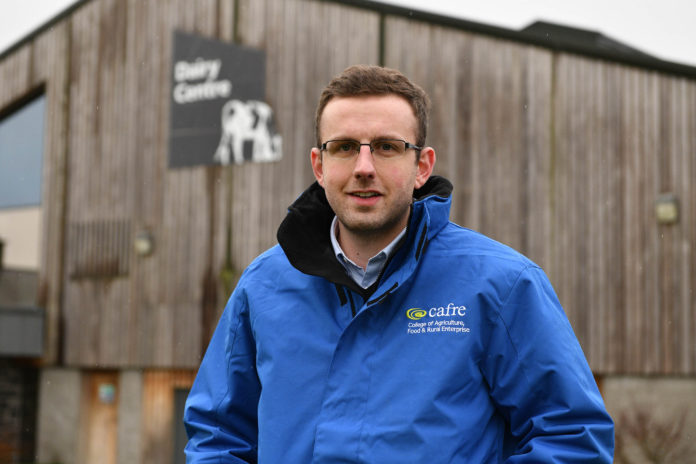Richard Gibson, CAFRE dairying adviser, looks at rearing replacement dairy heifers.
Heifer rearing and the associated cost of replacement stock on dairy farms have become more significant on many dairy farms in recent years.
This is largely due to increased replacement rates on farms. As a direct result, farmers require more heifers to maintain herd size.
This, coupled with the fact that Northern Ireland average herd size is steadily increasing, simply means more heifers, more facilities, land and labour required for the replacement enterprise.
Countless research has highlighted how strategic management during the rearing period can significantly impact the lifetime performance of the future dairy cow.
Replacement dairy heifers
So, what is a successful heifer rearing enterprise? What are the key performance indicators we need to look for?
“Get it right or pay the price”. The cost of maintaining any dairy herd is a major cost. It is basically the cost of replacements less the value of cull animals sold.
As a proportion of total variable production cost, it is typically the second-highest in the region of 3 to 4ppl, with only feed and forage costs greater on most farms.
This is a cost area that needs to be looked at, but few do, for many reasons. Firstly, it is largely hidden, unlike costs such as vet bills and dairy sundries.
Costs
You never write a cheque for ‘Herd Replacement Cost’. It is also not an easy cost to tackle.
It requires a clear plan, and, in many cases, a significant change in a production system is required. In turn, this needs to be planned strategically, and as expected, takes time to implement.
In many cases, the individual cost of rearing the heifer to the point of calving, while it is significant, it is not the most important figure.
The total number of heifers now required on many dairy farms is now a more significant issue for dairy farmers.
Replacement rates on many dairy farms range from 30 – 35%, just to maintain herd size.
Selecting heifers
For many producers, the starting point is to begin recording the reasons associated with culling to allow them to identify the core problems and then set about making improvements.
Make sure the heifers entering the herd have the highest genetics possible.
Getting heifers from birth to calving is a large investment on any farm, and to get the greatest return on the investment, the quality of stock needs to be the best possible.
The heifers certainly need to be genetically superior to the cows leaving the herd.
If possible, establish a herd genetic report from milk records, and use this information to inform your sire selection process.
Selecting sires
A recent business development group meeting in the Newtownards area established sire selection criteria for the host herd.
While the herd was high yielding, the focus for the selection was on:
- Cow fertility predicted transmitting ability (PTA);
- Milk component % PTA;
- Cow statue.
The targets for this particular herd sire selection included; milk 350kgs, butterfat 0.2%, protein 0.1%, fertility index 9.8, and stature 0.7.
The selection of sires this way allows the herd to develop in the most profitable and sustainable direction.
Age and weight
The objective on every dairy farm should be to rear heifers to enter the herd at the correct weight and age to achieve the best production and fertility performance.
Numerous studies in Ireland and abroad have shown that calving heifers at two years old improves lifetime performance and reduces rearing costs.
Therefore, it is essential to establish clear targets for heifer rearing and monitor performance closely over the rearing period.
If heifers are behind target, it is important to look for the causes of poor growth.
High-quality grass or silage, good parasite control and targeted meal feeding are key to good weight gain.
Now, any heifers behind target should be separated from the main group and fed accordingly. Now is the time to take corrective action – do not wait until next spring!
Growth targets
Here is a practical growth target protocol as follows:
The aim for your 2021 dairy calves in an autumn-calving profile is to have them submitted for service in late November/early December 2022.
These calves are just at weaning stage now, or possibly just past it.
Establish the weight of your replacement calves now, and refer to table 1.

However, remember the live-weight targets in table 1 are based on the mature weight of cows in your herd.
It is critical to establish the weight of your average mature cow before setting targets for the replacement stock.
Live-weight targets in table 1 are equal to 30%, 60% and 90% of mature live-weight at 6, 15, and 24 months of age.
So, for example, a mature target weight of 600kgs, the replacement heifer calf at weaning age should be 110kgs, then 180kgs at six months with a daily growth rate in this period of 0.73kgs/day required.
The same heifer at breeding age should be 360kgs with an ADG of 0.7kg/day required. Finally, this heifer should calve at 24 months at a target weight of 540kgs. This is 90% of the mature weight target.
For late-born calves that will be calving at 22 or 23 months, you will need to increase ADG targets in the table to meet the target live weight.
With the current pressure on margins from a steady escalation of costs in the sector, dairy farmers must continue to review all parts of the business to increase efficiency and control costs.
Conclusion
A closer focus on herd replacements can have a large impact on farm profitability. After all, it is the second-highest variable cost of dairying after feed.
Generally, most farms have considerable scope to reduce the cost of herd replacements with reduced age at first calving and reducing the number of cows culled.
Other articles:





